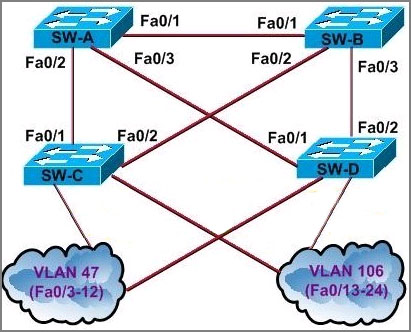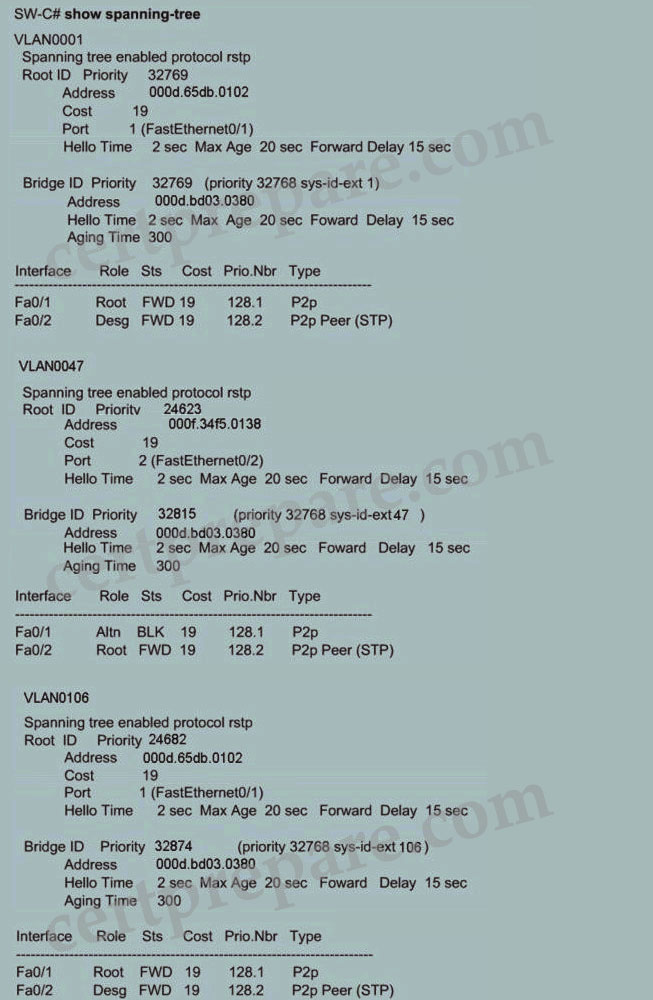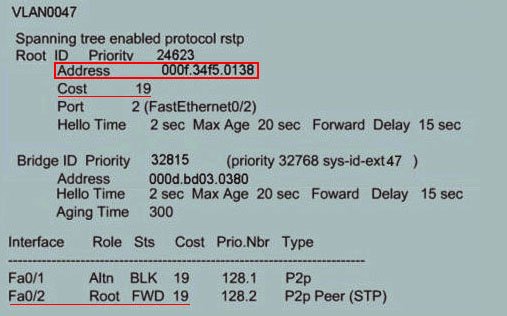STP Hotspot
Question
Online Incorporated is an internet game provide. The game service network had recently added an additional switch block with multiple VLANs configured. Unfortunately, system administrators neglected to document the spanning-tree topology during configuration. For baseline purpose, you will be required to identify the spanning-tree topology for the switch block. Using the output of “show spanning-tree” command on switch SW-C and the provided physical topology, answer the following questions:

The output of “show spanning-tree” command on SW-C:

Question 1:
Which spanning Tree Protocol has been implemented on SW-B?
A. STP/IEEE 802.1D
B. MSTP/IEEE 802.1s
C. PVST+
D. PVRST
E. None of the above
Answer: C
Explanation:
On the Fa0/2 interface we can see the type of connection is P2p Peer (STP) and Cisco says that: “!— Type P2p Peer(STP) represents that the neighbor switch runs PVST.” Please visit this link to understand more http://www.cisco.com/en/US/products/hw/switches/ps708/products_configuration_example09186a00807b0670.shtml
Question 2:
Which bridge ID belongs to SW-B?
A. 24623.000f.34f5.0138
B. 32768.000d.bd03.0380
C. 32768.000d.65db.0102
D. 32769.000d.65db.0102
E. 32874.000d.db03.0380
F. 32815.000d.db03.0380
Answer: A
Explanation:
Have a look at the output at VLAN0047:

Notice there are two “Cost” value in the picture, the above “Cost” is the total cost from the current switch to the root bridge while the second “Cost” refers to the cost on that interface (Fa0/2). Both these “Cost” are the same so we can deduce that the root bridge is connectly directly to this switch on Fa0/2 interface -> the root bridge is Switch B, and the “Address” field shows its MAC address 000f.34f5.0138. Notice Bridge ID = Bridge Priority + MAC address.
Question 3:
Which port role has interface Fa0/2 of SW-A adopted for VLAN 47?
A. Root port
B. Nondesigned port
C. Designated port
D. Backup port
E. Alternate port
Answer: C
Explanation:
We learned that Switch B is the root bridge for VLAN 47 so port Fa0/1 on SwitchA and Fa0/2 on SwitchC should be the root ports, and from the output of SwitchC, we knew that port Fa0/1 of SwitchC is in blocking state. Therefore its opposite port on SwitchA must be in designated state (forwarding).
So, can Fa0/2 of SW-A be in blocking state? The answer is no so that BPDU packets can be received on Fa0/1 of SW-C. It will remain in blocking state as long as a steady flow of BPDUs is received.
Question 4:
Which port state is interface Fa0/2 of SW-B in for VLANs 1 and 106?
A. Listening
B. Learning
C. Disabled
D. Blocking
E. Forwarding
F. Discarding
Answer: D
Explanation:
As explained in question 2, we can deduce SW-A is the root bridge for VLANs 1 and 106 so ports Fa0/1 on SW-B and SW-C will be the root ports. From the output of SW-C for VLANs 1 and 106, port Fa0/2 of this switch is designated (forwarding) so we can deduce interface Fa0/2 of SW-B is in blocking status.
Question 5:
Which bridge ID belongs to SW-A?
A. 24623.000f.34f5.0138
B. 32768.000d.bd03.0380
C. 32768.000d.65db.0102
D. 32769.000d.65db.0102
E. 32874.000d.db03.0380
F. 32815.000d.db03.0380
Answer: D
Explanation:
SW-A is the root bridge for VLANs 1 and 106 and we can easily find the MAC address of this root bridge from the output of SW-C, it is 000d.65db.0102. Notice that SW-A has 2 bridge IDs for VLANs 1 and 106, they are 32769.000d.65db.0102 and 24682.000d.65db.0102


